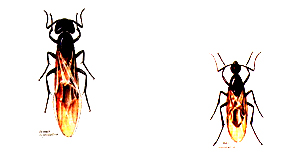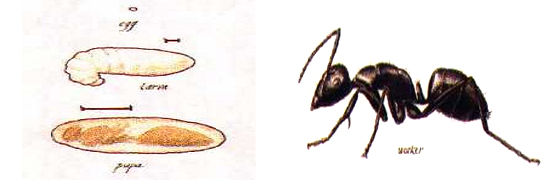
Besides being objectionable by their presence, carpenter ants damage wood by hollowing it out for nesting. They excavate galleries in wood, which have a smooth, sandpaper appearance. Wood, which has been damaged by carpenter ants, contains no mud-like material, as is the case with termites. Shredded fragments of wood, similar in appearance to course sawdust, are ejected from the galleries through preexisting cracks or slits made by the ants. When these sawdust accumulations are found, it is a good indication that the carpenter ant nest is nearby. Oftentimes, however, the excavated sawdust remains hidden behind a wall or in some other concealed area.
Nesting Behavior
Carpenter ants nest in both moist and dry wood, but prefer wood that is moist. Consequently, the nests are more likely to be found in wood dampened by water leaks, such as around sinks, bathtubs, poorly sealed windows/door frames, roof leaks and poorly flashed chimneys. Nests are especially common in moist, hollow spaces such as a wall void behind a dishwasher, or in a hollow porch column. Established carpenter ant nests often produce a “rustling” sound similar to the crinkling of cellophane.

The extent and potential damage to a home depends on how many nests are actually present within the structure, and how long the infestation has been active. Although large carpenter ant colonies are capable of causing structural damage, the damage is not normally as serious as that from termites. In some cases, the damage may be relatively insignificant, but locating and exposing the nest area can only determine this.
Carpenter Ant Management
Locating Carpenter Ant NestsThe most important and often most difficult part of carpenter ant control is locating the nest(s). Recent studies have shown that carpenter ants follow distinct scent trails between the satellite colonies and the parent nests. Minuteman will use this trailing behavior displayed by carpenter ants to locate and eliminate the nests. Often children and adults of the residence know where ants are seen, where large numbers are most prevalent, movement patterns, moisture in the structure, moisture problems of the past, if swarmers were seen, location of sawdust-like-material in piles, populations outdoors, etc.
Techniques Used in Managing Carpenter Ants
Once Minuteman has located the nest(s) or suspected problem nest areas, we will design a customized treatment program to effectively eliminate the carpenter ants. A few random applications of pesticides will not do the job. Minuteman uses the latest technology and materials to treat for the carpenter ants, which have invaded your home. Minuteman goal is to eliminate your problem while minimizing the amount of pesticides placed in your home. We accomplish this by a careful, targeted indoor and outdoor application. Minuteman has a preferred method of application to eliminate the carpenter ants within your home using a combination of highly effective baits. These baits have been specifically developed to attract carpenter ants to feed on them. Unknowingly the foraging ants feed on the baits, eventually return to the colony, and share this lethal bait with other ants. Therefore, unlike traditional pesticide sprays that are broadcasted into critical areas, baits are “delivered” right to the colony by their own workers. As the ants continue to feed on the baits, the colony will eventually be eliminated.
Occasionally there are situations when a colony of ants needs to be eliminated using a pesticide. Minuteman will use state-of-the-art equipment to inject a low hazardous pesticide directly into infested area. In certain situations, we may need to drill very small holes (1\8 inch in diameter) to eliminate these nests. This careful, targeted application reduces pesticide use in your home because we are targeting the infestations at their source.
Seasonal Exterior Treatments
Minuteman recommends that protective applications around the exterior of your home on a regular basis (Spring-Summer) to help keep carpenter ants from re-establishing. These regularly scheduled applications will not harm children, pets or the plants around your home.
Minuteman’s Guarantee
If an full interior treatment has been done, Minuteman will guarantee you service for the interior of your home at no addition charge should additional treatments be necessary, as long as there have been no lapses in the seasonal exterior treatments.
Carpenter Ant Prevention
What you can do to prevent the occurrence or reoccurrence of carpenter ant infestations:
• Correct any moisture problems that exist around the home, particularly in areas that have drainage or aeration problems (such as leaking roofs, gaps in siding, clogged gutters or faulting plumbing).
• Trim shrubbery and trees away from the house.
• Replace water-damaged or decayed wood. Wood should not be in contact with soil.
• Remove stumps and dead trees (A 50-foot cleared perimeter around the house is recommended).
• It is not necessary to remove healthy trees, but broken branches and any other damage or holes in nearby trees should be repaired or eliminated.
• Store firewood away from the house, preferably off the ground. This will minimize other insect problems associated with firewood. Bring inside only firewood that is about to be burned; examine and discard heavily infested pieces
Statement from the National Pest Management Association
“Pest management plays a major role in allowing us to live healthier, more prosperous and comfortable lives. The pest management professional relies as pesticide application as just one part of a total pest management program. The untrained consumer, who purchases a pesticide over-the-counter, can only make an intuitive judgement on how to safely apply the pesticide. However, the professional pest management technician relies on training, expertise, and more sophisticated techniques to apply pesticides in an environmentally safe manner.”

